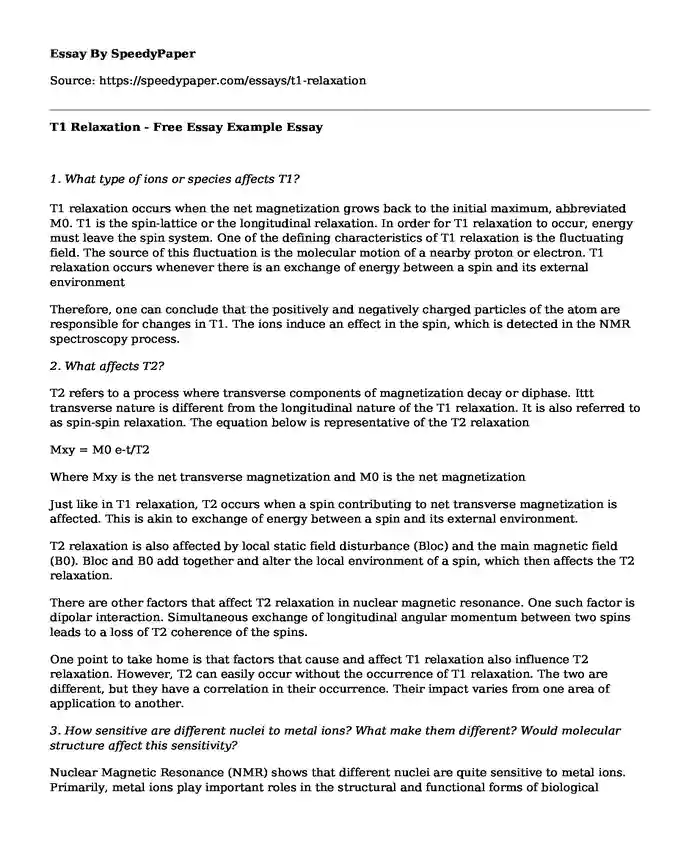1. What type of ions or species affects T1?
T1 relaxation occurs when the net magnetization grows back to the initial maximum, abbreviated M0. T1 is the spin-lattice or the longitudinal relaxation. In order for T1 relaxation to occur, energy must leave the spin system. One of the defining characteristics of T1 relaxation is the fluctuating field. The source of this fluctuation is the molecular motion of a nearby proton or electron. T1 relaxation occurs whenever there is an exchange of energy between a spin and its external environment
Therefore, one can conclude that the positively and negatively charged particles of the atom are responsible for changes in T1. The ions induce an effect in the spin, which is detected in the NMR spectroscopy process.
2. What affects T2?
T2 refers to a process where transverse components of magnetization decay or diphase. Ittt transverse nature is different from the longitudinal nature of the T1 relaxation. It is also referred to as spin-spin relaxation. The equation below is representative of the T2 relaxation
Mxy = M0 e-t/T2
Where Mxy is the net transverse magnetization and M0 is the net magnetization
Just like in T1 relaxation, T2 occurs when a spin contributing to net transverse magnetization is affected. This is akin to exchange of energy between a spin and its external environment.
T2 relaxation is also affected by local static field disturbance (Bloc) and the main magnetic field (B0). Bloc and B0 add together and alter the local environment of a spin, which then affects the T2 relaxation.
There are other factors that affect T2 relaxation in nuclear magnetic resonance. One such factor is dipolar interaction. Simultaneous exchange of longitudinal angular momentum between two spins leads to a loss of T2 coherence of the spins.
One point to take home is that factors that cause and affect T1 relaxation also influence T2 relaxation. However, T2 can easily occur without the occurrence of T1 relaxation. The two are different, but they have a correlation in their occurrence. Their impact varies from one area of application to another.
3. How sensitive are different nuclei to metal ions? What make them different? Would molecular structure affect this sensitivity?
Nuclear Magnetic Resonance (NMR) shows that different nuclei are quite sensitive to metal ions. Primarily, metal ions play important roles in the structural and functional forms of biological systems. It is important to note that biological systems are so synonymous with nuclei systems. This sensitivity of nuclei to metal ions is important in the prediction of atomic nuclei spin.
In the NMR, one can find the active nuclei through a prediction model. Nuclei that are NMR active will usually absorb electromagnetic radiation that is characteristic of the isotope in assessment. Electromagnetic radiation happens when there is a magnetic field, and it is created as a result of charged nuclei being on a spin in the said field.
NMR spectroscopy is optimized for electromagnetic radiations absorbed and emitted by nuclei. The nuclei could belong to an atom, an ion, or a molecule. The configuration of molecules is different from that of atoms or ions; hence the sensitivity shall definitely be quite different.
4. How is this method of T1 measurement used in MRI? Often Gd3+ is used in clinical applications.
Magnetic Resonance Imaging (MRI) applies the principles of T1 measurement to complete the scanning process. The MRI scanners are made in a way that they are strong magnetic fields, applying the NMR principle. In this process, the T1 relaxation technique is used to create a weighted image. The MRI scanning process allows magnetization to recover before measuring magnetic resonance, through a change of repetition time. When the image is T1-weighted, the signal received from MRI system is interpreted on three levels as high, intermediate, or low. Each of the three types of signal represents fluid characteristics that are then interpreted by radiology experts in healthcare.
The MRI scanners magnetic field uses the components of gadolinium (Gd3+). Gadolinium is used in making alloys that make great electromagnetic fields. The reason for clinical use of gadolinium is its excellent absorption of neutrons. Therefore, the MRI scanners are aided by gadolinium to create the needed electromagnetic fields for the scans to be completed. Diagnosis of cancerous tumors is done using MRI scanners, which are usually made of the gadolinium alloys.
T1 relaxation happens effectively on surfaces of gadolinium ions, and ensures that the black and white images are well displayed for the characteristics of the patient to be correctly deduced. A T1 weighted image is created when magnetization is induced in the same direction as the static magnetic field. This helps in ensuring the clarity of display of the image produced from the scan. Radiology experts can optimize the quality of the images by altering the different parameters of the MRI scanners.
Cite this page
T1 Relaxation - Free Essay Example. (2023, Aug 20). Retrieved from https://speedypaper.net/essays/t1-relaxation
Request Removal
If you are the original author of this essay and no longer wish to have it published on the SpeedyPaper website, please click below to request its removal:
- Free Essay on How to Force Yourself to Study Seriously
- Essay Example: Conversation vs. Speeches
- Participant Observation - Essay Example
- Facade Retrofitting Project
- Free Essay: Quality Improvement of an Injection-Molded Product Using Design of Experiments
- Essay Sample Answering Some Questions about Schooling
- Essay Sample on Informative Research Report On Adult Literacy
Popular categories





